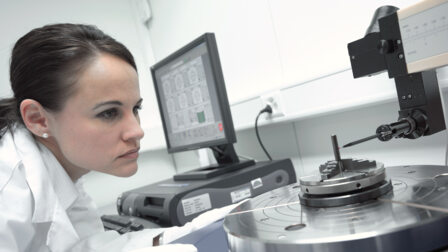Quality assurance testing methods
| Method | Attribute | Constraints | Precision | Destructive for | |
|---|---|---|---|---|---|
| Coating | Substrate | ||||
| Spherical abrasion | Coating thickness | Geometry, roughness | 0.3 - 0.5 μm | yes | yes |
| X-ray fluorescence (XRF) | Coating thickness | Geometry, composition (element) | 0.3 - 0.5 μm | no | no |
| Rockwell hardness (HRC) | Substrate hardness | Substrate hardness Geometry | ± 1 HRC | yes | yes |
| Rockwell test | Coating adhesion | Substrate hardness Geometry | ± 0.5 HF-Class | yes | yes |
| Colour measurement | Colour of the coating | Planar surface | ± 1 CIELAB-unit | no | no |
| Contact stylus profilometer | Roughness | Geometry | * | no | no |
* Function of test conditions





































